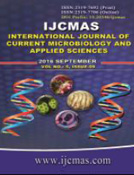


 National Academy of Agricultural Sciences (NAAS)
National Academy of Agricultural Sciences (NAAS)

|
PRINT ISSN : 2319-7692
Online ISSN : 2319-7706 Issues : 12 per year Publisher : Excellent Publishers Email : editorijcmas@gmail.com / submit@ijcmas.com Editor-in-chief: Dr.M.Prakash Index Copernicus ICV 2018: 95.39 NAAS RATING 2020: 5.38 |
Central venous catheter insertion is very common in ICU settings and is one of the serious and important causes for health care associated infections. We conducted this study to find out the bacteriological profile and antimicrobial susceptibility pattern of the isolates in central line associated blood stream infections in the ICU practice over a duration of 2 years. Patients admitted in ICU settings requiring central venous catheterization and presenting with signs of septicemia were investigated for catheter associated blood stream infections. The peripheral blood and the tip of central venous catheter were obtained simultaneously and processed in the microbiology lab. The isolated organisms were subjected for antimicrobial susceptibility testing. There were 11 episodes of central line associated blood stream infections of which 3 (27.27%) were due to Pseudomonas aeruginosa, 3 (27.27%) due to Acinetobacter species, 2 (18.18%) due to Staphylococcus aureus, 2 (18.18%) due to Klebsiella species and 1 (9%) due to Staphylococcus epidermidis. Central line associated blood stream infection rate of 22.6/1000 catheter days was observed in this study. Regular surveillance of catheter associated blood stream infection is required for better patient outcome as central venous catheter are increasingly being used at ICU.
 |
 |
 |
 |
 |